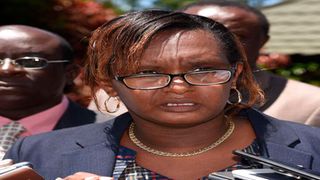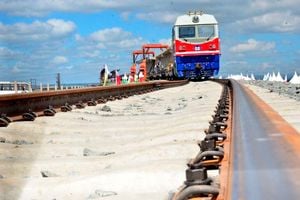
Former chairperson of Kenya Private Schools Association Mutheu Kasanga addresses the media at a past event. She has called on the government to work closely with the association’s members as they set up secondary schools to meet CBC needs.
| File | Nation Media GroupNews
Premium
Private primary schools eye CBC boom
What you need to know:
- The new section will increase the number of places for learners in secondary schools.
- The government has allocated Sh8 billion for the construction of 10,000 extra classrooms in public primary schools.
Private primary schools have started building extra classrooms to cash in on the opportunity to expand their businesses through offering the junior secondary level of the competency-based curriculum (CBC).
Primary schools stand to lose two classes once CBC phases out class 7 and 8 on full implementation, since the primary cycle will end at Grade 6, but the owners are seeking to make up for lost business by setting up junior secondary school (JSS) sections. Many primary schools do not currently have secondary school sections and learners exit at Standard 8 to join secondary school in other institutions.
A Ministry of Education Task Force has however encouraged primary schools to open junior secondary (Grades 7, 8 and 9) sections as part of the ongoing CBC changes, arguing it will Enhance Access, Relevance, Transition, Equity and Quality for Effective Curriculum Reforms Implementation. The Task Force was chaired by Prof Fatuma Chege, the principal secretary for Curriculum Reforms Implementation.
The new section will increase the number of places for learners in secondary schools. Whereas there are 10,359 public secondary schools, private ones are only 1,600.
Expansion of private schools will come in handy to help solve the congestion crisis in public secondary schools, with enrolment expected to increase from 4.3 million learners to 6 million in 2023. The government has allocated Sh8 million for the construction of 10,000 extra classrooms in public primary schools. The first phase is underway and will see 6,500 new classrooms constructed in 6,371 schools.
Most investors in education have previously concentrated on private primary schools, where over 11,000 institutions are registered compared to 23,000 public primary schools.
The panel also proposed the establishment of stand-alone junior secondary schools only for private schools that may wish to invest only for the level, with the learners proceeding for senior secondary in other schools.
Public secondary schools do not have this option, as all the 10,359 institutions will host both junior and senior secondary schools as will the existing 35 special needs education secondary schools.
Additionally, investors have the choice of establishing stand-alone senior secondary schools or the two combined. The ministry will also approve schools running from pre-primary to senior secondary school.
Mutheu Kasanga, the director of Lukenya Schools chair of the Kenya Private School Schools Association (Keppsa) until late last month, called on the government to involve the private sector in the provision of education and assist them to develop.
“It’s time to priotise the child without thinking about who owns the infrastructure. Building of 10,000 extra classrooms will still not be enough. The Ministry should talk to us so that we can walk that journey together, otherwise investment will be low,” she said.
Ms Mutheu said Keppsa had approached commercial banks to offer private schools favourable financial backing to make their development affordable.
“Every opportunity has an expense,” she added.
Ms Mutheu observed that there will be many ‘composite’ private schools running from pre-primary to senior secondary with some shared facilities like play fields. The same is likely to happen in sub-county schools, many of which exist adjacent to the primary schools from which they were hived off.
Mr John Wanyonyi, the principal of Kitengela International School told the Nation that the school’s application to host junior secondary has already been approved by the Ministry of Education. He also said the opportunity comes at a great cost.
“It’s an opportunity and huge expense because we had to develop separate infrastructure from the primary school. If a school is to use existing facilities, they have to restructure to give it a face of secondary school,” he said.
The ministry requires schools to build and equip laboratories for science, home science and technology.
Mr Wanyonyi said the school has completed a unit for junior secondary. The school also has another section that runs the international curriculum.
“We’ll also be forced to hire more teachers with the necessary requirements to teach in a secondary school. The minimum qualification is a diploma in education with two teaching subjects,” Mr Wanyonyi said, adding that other teachers have been asked to upgrade their qualifications.
Prof Chege’s team recommended the development of “a public-private partnership policy and a framework for basic education to incentivise the private sector to supplement access to basic education”.
Under the CBC structure, learners will join secondary school on average two years younger than under the 8-4-4. Some parents with children in private schools have welcomed the development since they do not wish their children to join boarding secondary schools, where there are other much older learners under the 8-4-4 system.
“My son is ten in Grade 5, which means he’ll be twelve when joining junior secondary. I’d rather he learns as a day scholar than join boarding school,” Ben Njiru told Nation.





